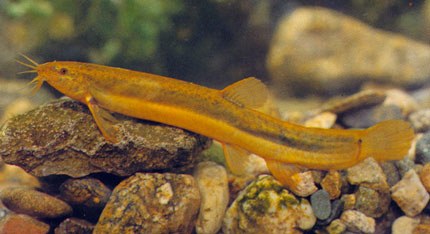Misgurnus mizolepis
Summary
Scientific Name: Misgurnus mizolepis, (Günther, 1888)
Common name: Chinese Weather Loach, Mud Loach, Pond Loach
Synonyms: Misgurnus mizolepis mizolepis, Misgurnus mizolepis fukien, Misgurnus mizolepis hainan
Distribution: China, Taiwan and Korea
Sexual Dimorphism: Females noticeably plumper when loaded with eggs. Males have longer pectoral fins, noticeable from above.
Maximum size: 10 inches (20 cm)
Similar to: Misgurnus anguillicaudatus, Misgurnus fossilis

Care: This is a big fish when adult and often very active. The species needs adequate space to move around and a fine substrate as they like to dig, and sometimes bury themselves with just the head protruding. Avoid coarse gravel as it can damage the delicate barbels.
Feeding: Easily fed. Accepts good quality flake, sinking pellets, thawed frozen Bloodworm, Mysis Shrimp, Brine Shrimp, Earthworm, and will avidly eat snails, etc.
Water parameters: pH: 7.0-8.0 Hardness: Medium Soft to Medium Max dh: 12
Temperature: 68 - 75ºF (20 - 23.8ºC)
Breeding: Bred commercially as a food-fish and for the ornamental fish trade.
Notes
Unlike Misgurnus anguillicaudatus, Misgurnus mizolepis is regarded as a sub-tropical fish. It is adaptable and tough, therefore escapees from commercial food-fish farms have succeeded in colonizing parts of many countries, but to a lesser extent than the far more adaptable M. anguillicaudatus.
In England, a permit is required to sell or keep "Weather Loaches", but the species actually listed is Misgurnus fossilis, a European species.
M. mizolepis is variable in colouring, but is often a more yellowish or brassy, almost metallic colour than the duller browns associated with its cousin. Some fish are boldly marked, while others have almost no markings beyond light speckling. A "golden" variety is available, which is hypo-melanistic, with dark eyes, plus very occasionally true albinos are seen.
It is known that some hybridization has occurred between the two species and it is possible that there are strains of "Weather Fish" that are impure. This may account for the vast differences in colour that are often seen. M. mizolepis is generally shorter-bodied than M. anguillicaudatus.
The fish acquired its name "Weather Fish" from their long recognized erratic behaviour during changes in barometric pressure. At these times the fish may become very active and agitated.
Part of the species' ability to survive poor conditions is due to its ability to swallow atmospheric air and pass it through the gut, extracting oxygen internally. Excess air is expelled via the anus. This ability has led to fish being found alive encased in mud, with no actual water present.
This somewhat "bulletproof" aspect of the fish does not mean that corners can be cut in its care in the aquarium, however. Big fish such as this require excellent filtration and frequent water-changes.
They are a very peaceful fish and can become quite tame, often feeding from their owner's hand. They are also quite long-lived, and if cared for well can become quite a Pet. Because of their sociability, they should not be kept singly as they like to sit in groups when at rest. They will often sidle up against one another and feel one another with their barbels. A group of three should be the minimum and even that small of a group will need quite a spacious aquarium. This should have a secure top as the fish are great escape artists.
Care should be taken when choosing fish in the shop. Look for signs of skin damage, odd bumps under the surface, or red areas on the body or fins. Do not choose fish that appear underweight compared to others in the tank or look obviously malnourished. Unfortunately, because this fish is so mass-produced as a food source it appears that there is less focus put on its well-being during catching and shipping than most other species for the ornamental fish trade.
Photo Gallery
Click to view all images of this species! |
|
Document Actions

